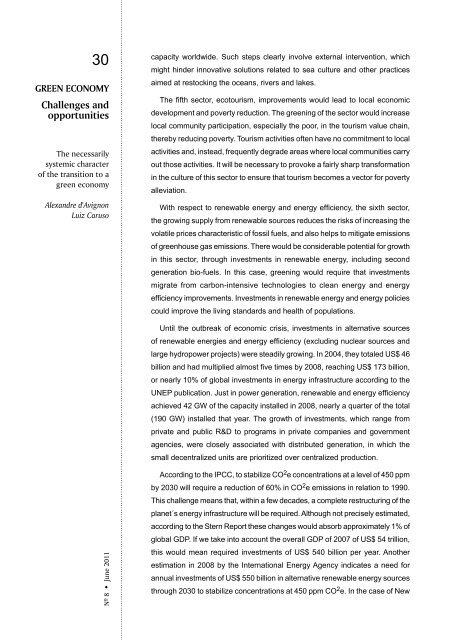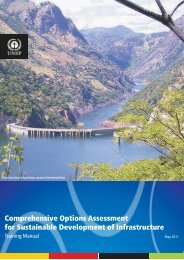Download Publication - Rio+20
Download Publication - Rio+20
Download Publication - Rio+20
Create successful ePaper yourself
Turn your PDF publications into a flip-book with our unique Google optimized e-Paper software.
30<br />
GREEN ECONOMY<br />
Challenges and<br />
opportunities<br />
The necessarily<br />
systemic character<br />
of the transition to a<br />
green economy<br />
Alexandre d'Avignon<br />
Luiz Caruso<br />
capacity worldwide. Such steps clearly involve external intervention, which<br />
might hinder innovative solutions related to sea culture and other practices<br />
aimed at restocking the oceans, rivers and lakes.<br />
The fifth sector, ecotourism, improvements would lead to local economic<br />
development and poverty reduction. The greening of the sector would increase<br />
local community participation, especially the poor, in the tourism value chain,<br />
thereby reducing poverty. Tourism activities often have no commitment to local<br />
activities and, instead, frequently degrade areas where local communities carry<br />
out those activities. It will be necessary to provoke a fairly sharp transformation<br />
in the culture of this sector to ensure that tourism becomes a vector for poverty<br />
alleviation.<br />
With respect to renewable energy and energy efficiency, the sixth sector,<br />
the growing supply from renewable sources reduces the risks of increasing the<br />
volatile prices characteristic of fossil fuels, and also helps to mitigate emissions<br />
of greenhouse gas emissions. There would be considerable potential for growth<br />
in this sector, through investments in renewable energy, including second<br />
generation bio-fuels. In this case, greening would require that investments<br />
migrate from carbon-intensive technologies to clean energy and energy<br />
efficiency improvements. Investments in renewable energy and energy policies<br />
could improve the living standards and health of populations.<br />
Until the outbreak of economic crisis, investments in alternative sources<br />
of renewable energies and energy efficiency (excluding nuclear sources and<br />
large hydropower projects) were steadily growing. In 2004, they totaled US$ 46<br />
billion and had multiplied almost five times by 2008, reaching US$ 173 billion,<br />
or nearly 10% of global investments in energy infrastructure according to the<br />
UNEP publication. Just in power generation, renewable and energy efficiency<br />
achieved 42 GW of the capacity installed in 2008, nearly a quarter of the total<br />
(190 GW) installed that year. The growth of investments, which range from<br />
private and public R&D to programs in private companies and government<br />
agencies, were closely associated with distributed generation, in which the<br />
small decentralized units are prioritized over centralized production.<br />
Nº 8 • June 2011<br />
According to the IPCC, to stabilize CO 2 e concentrations at a level of 450 ppm<br />
by 2030 will require a reduction of 60% in CO 2 e emissions in relation to 1990.<br />
This challenge means that, within a few decades, a complete restructuring of the<br />
planet´s energy infrastructure will be required. Although not precisely estimated,<br />
according to the Stern Report these changes would absorb approximately 1% of<br />
global GDP. If we take into account the overall GDP of 2007 of US$ 54 trillion,<br />
this would mean required investments of US$ 540 billion per year. Another<br />
estimation in 2008 by the International Energy Agency indicates a need for<br />
annual investments of US$ 550 billion in alternative renewable energy sources<br />
through 2030 to stabilize concentrations at 450 ppm CO 2 e. In the case of New

















